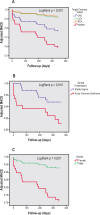Percutaneous coronary intervention using a full metal jacket with drug-eluting stents: major adverse cardiac events at one year
- PMID: 23821408
- PMCID: PMC3998154
- DOI: 10.5935/abc.20130139
Percutaneous coronary intervention using a full metal jacket with drug-eluting stents: major adverse cardiac events at one year
Abstract
Background: The clinical benefit of percutaneous coronary intervention (PCI) for long coronary lesions is unclear; furthermore, concerns have been raised about its safety.
Objectives: To evaluate the predictors of major adverse cardiac events (MACE) associated with PCI using a full metal jacket (FMJ), defined as overlapping drug-eluting stents (DES) measuring >60 mm in length, for very long lesions.
Methods: We enrolled 136 consecutive patients with long coronary lesions requiring FMJ in our single-center registry. The primary endpoint included the combined occurrence of all-cause death, myocardial infarction (MI), and target vessel revascularization (TVR). Demographic, clinical, angiographic, and procedural variables were evaluated using stepwise Cox regression analysis to determine independent predictors of outcome.
Results: The mean length of stent per lesion was 73.2 ± 12.3 mm and the mean reference vessel diameter was 2.9 ± 0.6 mm. Angiographic success was 96.3%. Freedom from MACE was 94.9% at 30 days and 85.3% at one year. At the one-year follow-up, the all-cause mortality rate was 3.7% (1.5% cardiac deaths), the MI rate was 3.7%, and the incidence of definite or probable stent thrombosis (ST) was 2.9%. Female gender [hazard ratio (HR), 4.40; 95% confidence interval (CI), 1.81-10.66; p = 0.001) and non-right coronary artery PCI (HR, 3.49; 95%CI, 1.42-8.59; p = 0,006) were independent predictors of MACE at one year. Freedom from adverse events at one year was higher in patients with stable angina who underwent PCI (HR, 0.33; 95%CI, 0.13-0.80; p = 0.014).
Conclusions: PCI using FMJ with DES for very long lesions was efficacious but associated with a high rate of ST at the one-year follow-up. However, the rate of cardiac mortality, nonprocedure-related MI, and MACE was relatively low. Target coronary vessel PCI, clinical presentation, and female gender are new contemporary clinical factors that appear to have adverse effects on the outcome of PCI using FMJ for long lesions.
Conflict of interest statement
Figures
Similar articles
-
Extended follow-up following "full-metal jacket" percutaneous coronary interventions with drug-eluting stents.Catheter Cardiovasc Interv. 2014 Dec 1;84(7):1042-50. doi: 10.1002/ccd.25455. Epub 2014 Mar 11. Catheter Cardiovasc Interv. 2014. PMID: 24550090
-
Comparison of mid-term clinical outcomes between "complete full-metal jacket strategy" versus "incomplete full-metal jacket strategy" for diffuse right coronary artery stenosis with drug-eluting stents.J Cardiol. 2017 Jun;69(6):823-829. doi: 10.1016/j.jjcc.2016.09.014. Epub 2016 Nov 2. J Cardiol. 2017. PMID: 27816320
-
Improved safety and reduction in stent thrombosis associated with biodegradable polymer-based biolimus-eluting stents versus durable polymer-based sirolimus-eluting stents in patients with coronary artery disease: final 5-year report of the LEADERS (Limus Eluted From A Durable Versus ERodable Stent Coating) randomized, noninferiority trial.JACC Cardiovasc Interv. 2013 Aug;6(8):777-89. doi: 10.1016/j.jcin.2013.04.011. JACC Cardiovasc Interv. 2013. PMID: 23968698 Clinical Trial.
-
Drug-Eluting Versus Bare Metal Stents in Saphenous Vein Graft Intervention: An Updated Comprehensive Meta-Analysis of Randomized Trials.Cardiovasc Revasc Med. 2019 Sep;20(9):758-767. doi: 10.1016/j.carrev.2018.11.013. Epub 2018 Nov 22. Cardiovasc Revasc Med. 2019. PMID: 30503811
-
Drug eluting versus bare metal stents for percutaneous coronary intervention of saphenous vein graft lesions: An updated meta-analysis of randomized controlled trials.Cardiovasc Revasc Med. 2018 Oct-Nov;19(7 Pt B):837-844. doi: 10.1016/j.carrev.2018.03.025. Epub 2018 Apr 3. Cardiovasc Revasc Med. 2018. PMID: 29685385
Cited by
-
Ivabradine in Patients with Stable Coronary Artery Disease: A Rationale for Use in Addition to and Beyond Percutaneous Coronary Intervention.Clin Drug Investig. 2017 Feb;37(2):105-120. doi: 10.1007/s40261-016-0472-1. Clin Drug Investig. 2017. PMID: 27766510 Review.
-
[Comparison of long-term outcomes between a single versus a multiple stent brand strategy during "full metal jacket"procedures].REC Interv Cardiol. 2023 Oct 30;6(1):52-54. doi: 10.24875/RECIC.M23000410. eCollection 2024 Jan-Mar. REC Interv Cardiol. 2023. PMID: 40417729 Free PMC article. Spanish. No abstract available.
References
-
- Kobayashi Y, De Gregorio J, Kobayashi N, Akiyama T, Reimers B, Finci L, et al. Stented segment length as an independent predictor of restenosis. J Am Coll Cardiol. 1999;34(3):651–659. - PubMed
-
- Dawkins KD, Grube E, Guagliumi G, Banning AP, Zmudka K, Colombo A, et al. TAXUS VI Investigators Clinical efficacy of polymer-based paclitaxel-eluting stents in the treatment of complex, long coronary artery lesions from a multicenter, randomized trial: support for the use of drug-eluting stents in contemporary clinical practice. Circulation. 2005;112(21):3306–3313. - PubMed
-
- Aoki J, Ong AT, Rodriguez Granillo GA, McFadden EP, van Mieghem CA, Valgimigli M, et al. "Full metal jacket" (stented length ≥ 64 mm) using drug-eluting stents for de novo coronary artery lesions. Am Heart J. 2005;150(5):994–999. - PubMed
-
- Lee CW, Park KH, Kim YH, Hong MK, Kim JJ, Park SW, et al. Clinical and angiographic outcomes after placement of multiple overlapping drug-eluting stents in diffuse coronary lesions. Am J Cardiol. 2006;98(7):918–922. - PubMed
-
- Andron M, Ramsdale DR, Rao A, Ramsdale KA, Albouaini K. Clinical outcomes after percutaneous coronary intervention involving very long segments of drug-eluting stent implantation: single-center experience. J Invasive Cardiol. 2009;21(2):46–50. - PubMed
MeSH terms
LinkOut - more resources
Full Text Sources
Other Literature Sources
Miscellaneous


